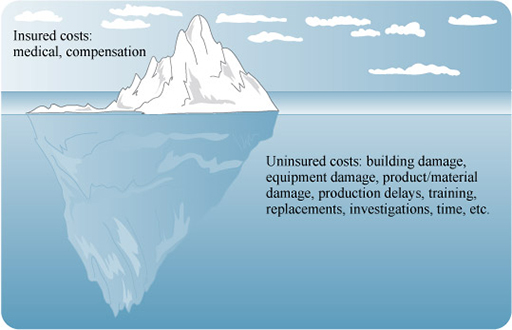2.4 After the accident
Accidents are much more than the initial event. They have far-reaching consequences, but also costs. As part of his work with 1500 organisations, Heinrich examined many thousands of insurance records and interviewed many staff members. He found that the uninsured costs (which he called the indirect costs) were typically four times higher than the direct costs covered by insurance. This relationship is commonly represented as an iceberg (Figure 9).
List some of the additional uninsured costs of a workplace accident.
You may have thought of the following:
- the damage to an organisation’s reputation, leading to loss of customers
- fines levied by the courts if the organisation is found to be negligent
- increased insurance premiums in future years
- increased scrutiny from regulators
- difficulty in obtaining permits and planning for future developments.
Later work by the UK HSE’s Accident Prevention Advisory Unit (APAU) on non-injury accidents included all unintended events causing loss, even when there was no potential for causing personal injury. It found that the ratio of uninsured costs to insured costs was substantially greater than Heinrich’s 4:1 ratio, ranging from 8:1 to 36:1 (HSE, 1999, p. 56). Clearly, the mix of industrial activities, the management and training within the organisations, and the definitions of accident categories have contributed to different results between the studies since Heinrich’s time. Taking Buncefield as an example, after a four-month trial at St Albans Crown Court, five companies were found guilty of various offences and ordered to pay a total of £9.5 million in fines and costs over and above the initial incident costs.
The other aspects of potential loss depend on many factors related to the original incident. How these other ‘uninsured losses’ might be dealt with may depend on the availability and cost of cover, as well as the organisation’s perception of the risks of such losses. For the present, however, it is enough to accept that major industrial incidents have important consequences in terms of death, ill health, and environmental and economic impact beyond the initial incident.

